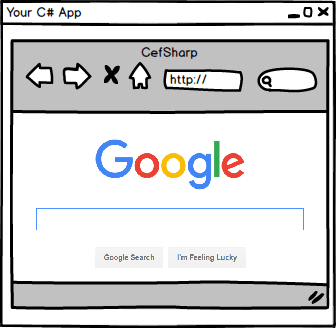

- #CHROMIUM EMBEDDED FRAMEWORK EXAMPLE HOW TO#
- #CHROMIUM EMBEDDED FRAMEWORK EXAMPLE PDF#
- #CHROMIUM EMBEDDED FRAMEWORK EXAMPLE CODE#
- #CHROMIUM EMBEDDED FRAMEWORK EXAMPLE LICENSE#
#CHROMIUM EMBEDDED FRAMEWORK EXAMPLE HOW TO#
Note: All these codes are quick and dirty since I needed to check how to make CEF run with OpenGL or SDL2 before switching to Godot Engine.MacOS X: is more complex and is not working yet: #4.install.sh into Python script, but you can adapt this one on the version of this project for Godot here. Windows: version can work quite easily but I did not translate the.Linux: It's working on my Linux 64-bit Debian 11.You can achieve the API by adding more methods such as previous/next page, reload, and zoom. While this repo shall be considered as a proof of concept for, pull requests and help are welcome to improve these examples :) Note 2: I find the system not very reactive compared to the official cefsimple example. Update: I have a functional keyboard for Godot/CEF but I have not yet patched this current repo for SDL and glfw3 (request me if you needed it urgently). Note 1: The keyboard/mouse event conversion from SDL2/glfw3 to CEF has to be fixed.
#CHROMIUM EMBEDDED FRAMEWORK EXAMPLE PDF#
The projection of the mouse to the PDF plan has not been made. In this screenshot, you can see two browsers: one running YouTube, and the second running a PDF. Click on the image to see the YouTube video of the demo.
#CHROMIUM EMBEDDED FRAMEWORK EXAMPLE CODE#
) where you cannot modify their main(int argc, char* argv) code source to add your CEF code. Do we really require two separate processes? Yes for applications that access to main(int argc, char* argv) since CEF also uses it or for applications such as game engines (Godot, Unreal, Unity. The main constraint is the path of the secondary process shall be canonic (and this is a pain to get the real path). What is "two separated processes" exactly? Just an extra fork: the main process forks itself and calls the secondary process, which can fully access its own main(int argc, char* argv). You have to know that CEF modifies the content of your argv and this may mess up your application if it also parses the command line (you can back it up, meaning using a std::vector to back up argv and after CEF init to restore values in argv). Two processes are needed when CEF cannot directly access the main(int argc, char* argv) function of your application. cefsimple_separate: with two separate processes.cefsimple_opengl: using OpenGL Core (>= 3.3).

In this repo is the updated version of these repos.

From memory, issues of these repos come from the fact that the CEF API has evolved, and the command line access has been broken and as a consequence, CEF is forking forever. So they are not safe to use! When starting, CEF will create several forks and needs to access the command line ( main(int argc, char* argv)) to give commands to the child process. They are outdated (more than > 4 years), the CEF API changed, and when I compiled they crashed by forking indefinitely the application until my Linux fell down. I tried the following GitHub repos but without success:
#CHROMIUM EMBEDDED FRAMEWORK EXAMPLE LICENSE#
This project shall be considered as proof of concept for this final project the code is not proper, will not be maintained and not all mouse/keyboard callbacks are plugged!įor the GitHub project named Stigmee using Godot Engine, and particularly for its CEF native module (under GPL license, but also forked as MIT license ), I needed to make my hand on something simpler and therefore prototype (proof of concept) and modify the C++ CEF example named cefsimple to replace the X11 display by either SDL2 or OpenGL Core (glew, glfw3). Chromium Embedded Framework's cefsimple Off-Screen Rendering using SDL2 or Core OpenGL


 0 kommentar(er)
0 kommentar(er)
